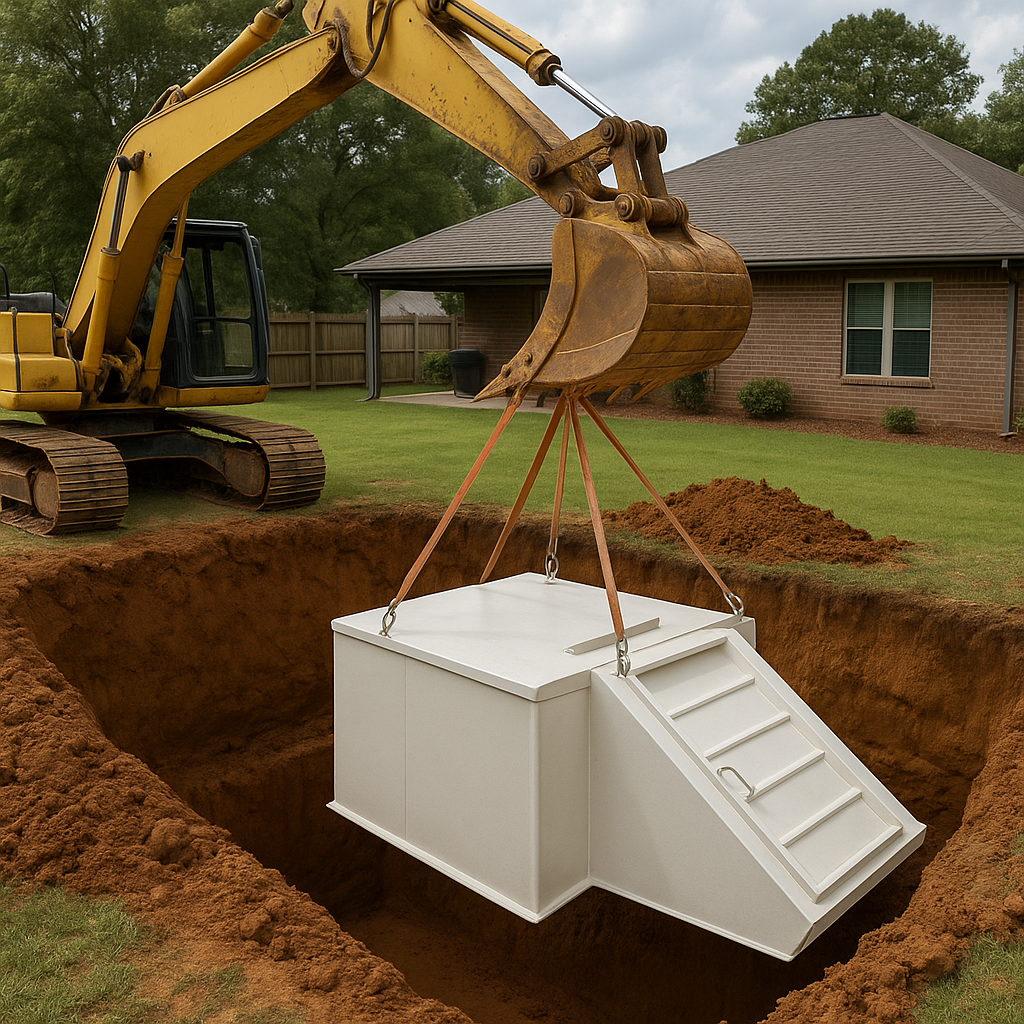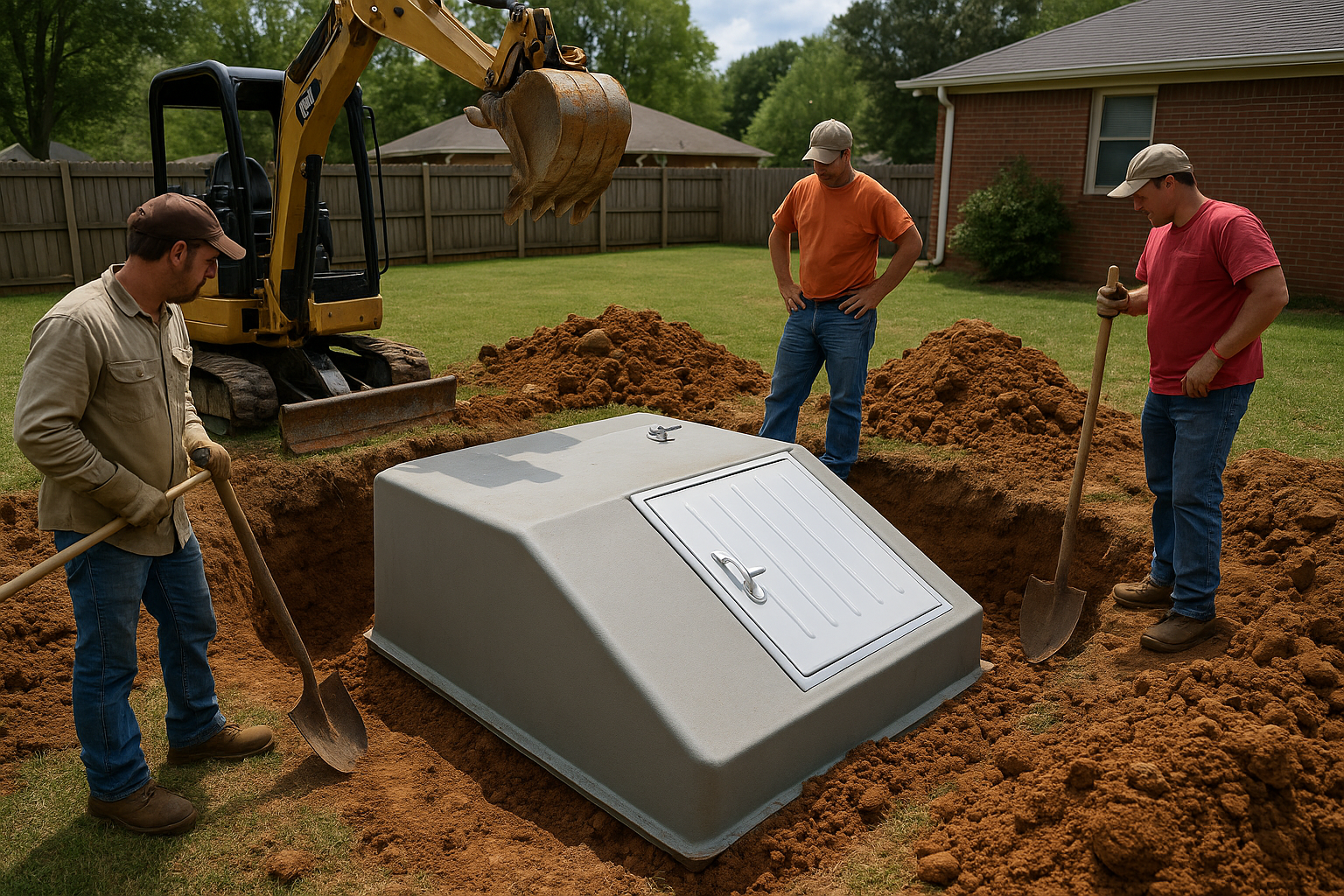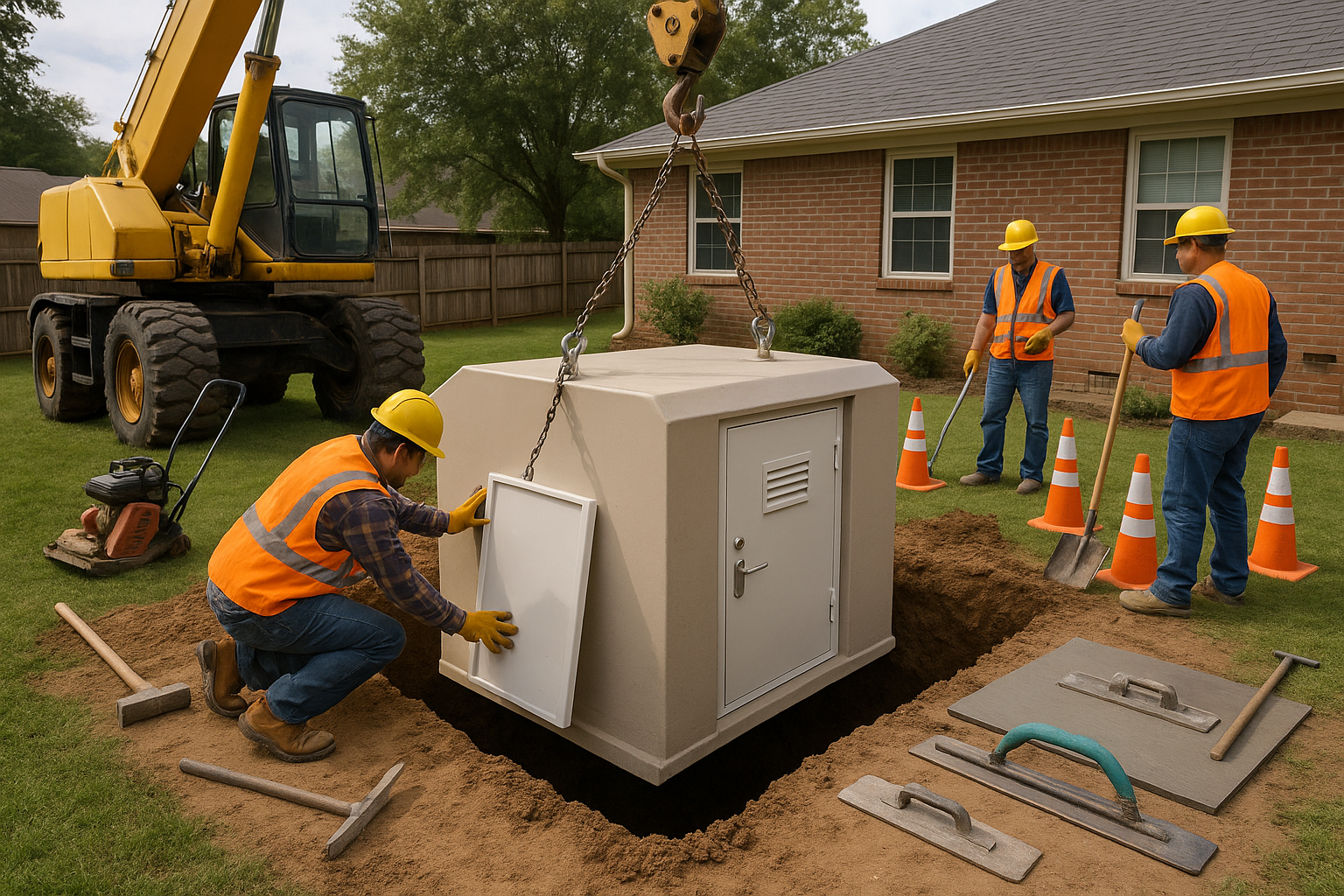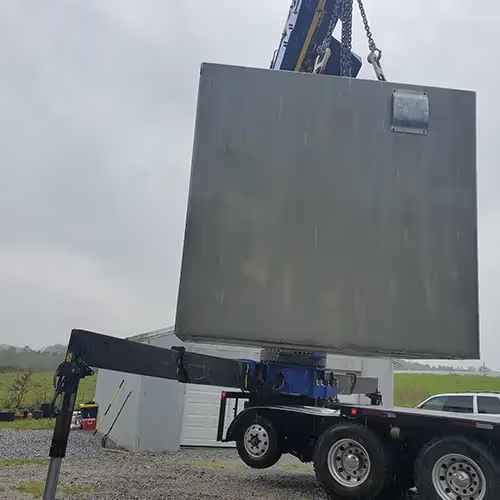Installing an Above Ground Tornado Shelter: Step-by-Step Guide for Homeowners


Have you ever wondered what it really takes for tornado shelter installation at home? For many Alabama homeowners, installing a shelter isn’t just about peace of mind—it’s about ensuring your family has a safe, dependable space with backyard tornado protection and home tornado protection during severe weather events. When tornadoes strike, seconds can make a difference, and a properly installed shelter ensures everyone has a secure place to ride out the storm.
While the idea of installing a shelter might seem intimidating at first, understanding the right steps, tools, and safety considerations makes the process manageable. For those interested in hands-on projects, a DIY storm shelter guide in Alabama provides detailed instructions and tips for homeowners wanting to create a personal safe space.
This guide walks you through every step of installing an above ground storm shelter, including tornado shelter location planning, secure tornado shelter foundation preparation, and safety checks. Whether you choose to place a residential tornado safe room in a garage, patio, or backyard, this guide provides practical tips for ensuring accessibility and durability. You’ll also learn how to use tornado shelter kits or a DIY storm shelter guide for smaller projects, as well as the considerations for prefab tornado shelter installations.
Installing a tornado shelter is a long-term investment in safety, comfort, and property value. By following the tornado shelter building steps carefully, you can create a secure above ground tornado bunker that protects your family from extreme wind, flying debris, and flooding hazards while giving you peace of mind throughout storm season.
Understanding Above-Ground Tornado Shelters
Historically, tornado shelters were primarily underground bunkers, built to protect families from violent storms. Over time, advances in engineering and safety standards led to the rise of above ground tornado bunkers, which combine accessibility, durability, and modern safety technology. Today, tornado shelter kits and DIY storm shelter guides allow homeowners to customize their safe spaces with a variety of materials, designs, and sizes. Unlike traditional in-ground shelters, above-ground units are easier to access during emergencies, eliminating the need for stairs or ladders and providing an efficient route for all family members.
Modern steel tornado shelters or reinforced concrete structures often include a tornado shelter anchoring system to prevent movement, tornado shelter flooring for comfort and stability, and storm shelter drainage system features to mitigate flooding. For guidance on concrete foundations, homeowners can refer to the Concrete Storm Shelters Alabama Guide. These residential storm shelter options can be installed indoors, in garages, or outdoors, providing flexibility for space-limited properties. FEMA-certified designs ensure that shelters meet strict wind resistance and debris impact requirements.
By understanding how tornado shelter location planning, foundation preparation, and secure tornado shelter foundation installation affect performance, homeowners can make informed decisions. Whether selecting a prefab tornado shelter or customizing a residential tornado safe room, understanding these fundamentals ensures your family receives the highest level of protection during severe weather events.
Key Components of an Above-Ground Tornado Shelter
A reliable above ground storm shelter is more than a sturdy box—it is a precisely engineered safety structure. Knowing each component ensures proper selection, installation, and maintenance.
Reinforced Structure – Constructed with heavy-duty steel tornado shelter or reinforced concrete, these shelters withstand EF5 tornado winds while resisting flying debris.
Anchoring System – Strong bolts and anchors secure the unit to a secure tornado shelter foundation, part of proper anchoring storm shelter procedures, preventing lifting or movement during storms.
Impact-Resistant Door – The tornado shelter door design includes multiple locking mechanisms and impact resistance to protect occupants during debris collisions.
Ventilation System – Proper storm shelter ventilation ensures adequate airflow, keeping occupants comfortable during extended storms or emergency storm shelter situations.
Emergency Supplies Storage – Dedicated shelving allows room for essentials like flashlights, radios, first aid kits, and water, supporting a full family storm shelter plan.
Other considerations include tornado shelter flooring for comfort, tornado shelter drainage system to prevent flooding, and adherence to tornado shelter permit requirements. For more details on permits and local codes, check the Alabama Storm Shelter Code Checklist. A combination of these elements guarantees that the shelter performs effectively, providing protection, comfort, and peace of mind for homeowners and their families.
Benefits of Installing an Above-Ground Tornado Shelter
Investing in an above ground storm shelter offers numerous advantages beyond protection from tornadoes. These shelters provide both physical safety and long-term reassurance, especially in tornado-prone regions.
Enhanced Safety – Engineered to meet FEMA and ICC-500 standards, these units offer a wind resistant shelter capable of withstanding EF5 tornadoes and flying debris.
Easy Accessibility – Unlike underground shelters, above-ground designs provide simple, step-free entry, ideal for a residential tornado safe room with children or elderly family members.
Flood Protection – Elevated placement ensures storm shelter drainage system efficiency, avoiding the common issue of underground flooding.
Quick Installation – Many prefab tornado shelters and tornado shelter kits can be installed in a few hours with proper preparation, whether indoors, in garages, or on a concrete pad.
Durability and Maintenance – Heavy-duty materials require minimal tornado shelter maintenance, offering decades of reliability.
Property Value – Investing in certified best tornado shelter brands not only protects your family but also enhances long-term home value.
For financial assistance, homeowners can explore Alabama storm shelter grants to help offset installation costs. By understanding these benefits, homeowners can make informed decisions on tornado shelter installation, backyard tornado protection, and home tornado protection, ensuring both safety and peace of mind.
Challenges of Installing an Above-Ground Tornado Shelter
While the advantages are clear, installing an above ground tornado bunker comes with challenges that homeowners should plan for.
Cost – Storm shelter installation cost can vary significantly based on size, materials, and certifications, though long-term safety benefits often outweigh initial expenses.
Space Requirements – Adequate space for tornado shelter location planning is crucial; garages, patios, or corners of backyards are often the best options.
Permits and Regulations – Understanding tornado shelter permit requirements is essential to avoid delays and ensure compliance.
Anchoring and Safety – Correctly implementing the tornado shelter anchoring system is critical to prevent damage or accidents during severe storms.
Practical solutions include:
- Choosing locations that maximize accessibility and safety for home tornado protection.
- Hiring certified storm shelter contractors or storm shelter installation companies.
- Considering weatherproof storm shelter options for durability.
- Exploring financing or grants to offset above ground shelter price.
With careful planning, these challenges can be overcome, resulting in a secure, reliable residential tornado safe room or emergency storm shelter for your family.
How to Install Your Above-Ground Tornado Shelter Step by Step
Choose the Right Location – Identify a safe, accessible site, planning your building tornado shelter entrance for quick access.
Verify Codes and Permits – Confirm all tornado shelter permit requirements are met before installation by referring to the Alabama Storm Shelter Code Checklist.
Prepare the Foundation – Install a concrete storm shelter base and ensure secure tornado shelter foundation measures are followed.
Professional Installation – Hire certified storm shelter installation service or experienced storm shelter contractors to guarantee proper setup.
Inspect and Test – Follow the tornado shelter inspection checklist, ensuring doors, ventilation, and seals function correctly.
Stock Your Shelter – Include essentials for your emergency storm shelter: water, first aid, flashlights, and communication devices.
Create a Family Plan – Develop a family storm shelter plan with clear instructions for all household members.
For DIY installations, a DIY storm shelter guide or tornado shelter kits can simplify the process, allowing homeowners to combine safety and efficiency.
The Future of Above-Ground Tornado Shelters
Above-ground shelters are evolving with tornado safe house upgrades, modular designs, and tech integration. Future models may include smart systems, solar power, emergency lighting, and storm shelter ventilation improvements, enhancing comfort and security.
Homeowners are exploring residential storm shelter options, evaluating best tornado shelter brands, and adopting tornado shelter safety tips to ensure long-term protection. As technology advances, shelters are becoming more sustainable, durable, and accessible, offering more than just safety—they provide peace of mind and confidence during severe weather.
Your Path to a Safer, More Prepared Home
Investing in above ground storm shelter installation ensures tornado protection for homes. Understanding tornado shelter building steps, proper foundation preparation, tornado shelter anchoring system, and maintenance ensures a reliable and safe structure.
Consult storm shelter installation companies, explore tornado shelter installation service options, and implement a family storm shelter plan. Whether selecting a residential tornado safe room, above ground tornado bunker, or emergency storm shelter, proper planning, installation, and maintenance deliver a weatherproof storm shelter that protects your family while enhancing property value.
For homeowners in Alabama, local regulations and incentives can make installation easier. Reviewing Alabama storm shelter grants can help offset costs, while consulting a DIY storm shelter guide or hiring storm shelter contractors ensures your shelter meets safety standards.
Stay prepared and safe with modern above ground storm shelter solutions designed to withstand severe weather and provide lasting peace of mind. Regular tornado shelter maintenance, inspections, and adherence to tornado shelter permit requirements will keep your safe space effective and ready for any storm. With the right knowledge, planning, and resources, installing an above-ground tornado shelter can be a smooth, rewarding process that transforms your home into a secure haven during extreme weather events.




